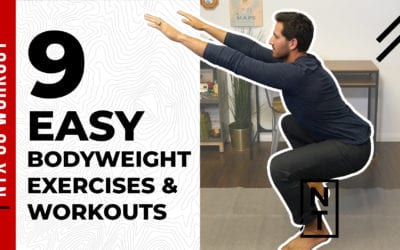To get strong, Coach Mark Rippetoe keeps things simple. In his seminal book Starting Strength, he lays out a simple prescription for building pure strength as efficiently as possible: Train three days a week, focusing on five different movements, and lift heavier every session.
There’s just one thing: all the movements are done with a barbell.
There’s no doubt that using a barbell is the best way to develop strength, but not everyone has access to a squat rack. Rippetoe would argue to make the effort to find a gym that does.
But for many just getting into the gym to strength train is an achievement in itself, so we want to keep things convenient. Condo, office, and hotel gyms will generally be the most accessible options. They’re also least likely to have a squat rack. However, they most likely have a dumbbell set.
Dumbbells and kettlebells are also space saving enough to purchase and keep in an apartment.
So how do we get strong and modify the simplicity and effectiveness of Starting Strength with dumbbells or kettlebells?
What is Starting Strength?
Starting Strength focuses on three movement patterns: squat, push, and pull. They’re expressed as five movements: squat, shoulder press, bench press, deadlift, and power clean.
The early stages of Starting Strength alternate between these two workouts:
| Day A | Day B |
| Squat 3 sets x 5 reps | Squat 3 sets x 5 reps |
| Shoulder Press / Bench Press 3 sets x 5 reps | Shoulder Press / Bench Press 3 sets x 5 reps |
| Deadlift 1 set x 5 reps | Power Clean 5 sets x 3 reps |
That’s only three movements each session. You squat every session (three times a week) but alternate the pushing and pulling movements. The goal is to increase the weight every single session.
This approach always produces a linear increase in strength because it takes advantage of the most basic rule of biology: organisms adapt to their environment if the stress causes an adaptation and if the stress is not overwhelming in its magnitude.
Mark Rippetoe, Starting Strength
Learn more about Starting Strength.
Dumbbell Strength
Let’s just get this out of the way: you cannot get the same load and stimulus from a dumbbell that you can from a barbell. It’s very easy to setup a barbell with 135 pounds and squat. It’s a lot trickier to curl or clean two 65 pound dumbbells to your shoulder and squat.
But if we’re looking at the continuum of no strength training on one end and barbell training on the other end, I’d gladly settle for the middle with dumbbell work rather than no training.
Let’s breakdown each barbell movement we see in Starting Strength and how to do it with dumbbells.
Squat
Starting Strength uses a low bar back squat, which is more of a power lifting specific variation of the squat because it allows you to move the most weight, but it also recruits the most amount of muscles and therefore gets you stronger faster.
With dumbbells we’re just going to focus on doing any type of squat. There are two variations that let us move the most weight.
The first is the goblet squat. This works with dumbbells or kettlebells. We cup the weight in the center of our chest and squat.
The second variation is a dumbbell front squat. This lets us use two dumbbells, so we can theoretically load more weight (as long as we can get it into position).
Shoulder Press
Modifying the press is pretty simple. Rack up a dumbbell in each hand and then press it straight up. If you have a home gym setup and are limited with equipment (say you only have kettlebells), you can do this as a one armed variation and just do one side at a time.
Bench Press
I’d argue that bench press novices should start with dumbbells, even if they have access to a bar. We all have a dominant side so it’s only natural that one side of our body is stronger than the other. With the bench press it’s extremely easy for the stronger side to overcompensate and do more of the lifting with the bar, leaving the weaker side lagging in developing.
The advantage of dumbbells is it exposes these weaknesses. Each side is on its own and can either lift the weight or not.
So start with dumbbell bench presses and get both sides feeling strong.
Deadlift
The deadlift is the trickiest to modify, only because it’s everyone’s heaviest lift so dumbbells will stop being a challenge fairly quickly. If that becomes the case and you still don’t have access to a barbell, increase the reps to add more volume (more on that below).
If you have access to heavy kettlebells you can also do sumo deadlifts.
Power Clean
The key with the power clean, both with dumbbells and barbells, is to focus on an explosive hip extension (basically straightening out your entire body) to make the weight move up, and not just doing a fancy curl.
Programming for Volume
We have the movements down. Now let’s modify the workouts to accommodate the lighter weights and still get strong.
Focus on Total
Volume is the total amount of weight we move over an entire session. If we do 5 reps of 135 lb squats for 3 sets, the volume would be: 3 x 5 x 135 = 2025 lb.
To get the same volume with dumbbells, we’d need to do 5 sets of 5 reps with 80 lb total (two 40 lb dumbbells).
With Starting Strength, the sets and reps stay the same and only the weight increases, because with a barbell you have the luxury of finessing the weight.
We don’t have that luxury with dumbbells. They’re usually in five pound increments, so if you’re squatting with two that’s an automatic ten pound jump.
So we’ll add our finesse by also tweaking the number of reps and sets, to continue to increase the volume.
In Practice
What’s this look like when we put a plan together that uses both the weight and repetitions as variables?
A week of squatting could look like:
Week 1
Day 1: 5 x 5 x 50 lb (1250 lb)
Day 2: 5 x 6 x 50 lb (1500 lb)
Day 3: 6 x 6 x 50 lb (1800 lb)
Week 2
Day 1: 5 x 6 x 60 lb (1800 lb)
Day 2: 5 x 7 x 60 lb (2100 lb)
…
Each training session must have a definite achievable goal, usually an increase over the previous workout in the amount of weight lifted, or another definable objective based on the person’s training history.
Mark Rippetoe, Starting Strength
Will goblet squatting 50 pounds four times produce the same stimulus and muscle recruitment as squatting 200 pounds once? No. But it’ll get you stronger than squatting zero pounds zero times.
Conclusion
If your goal is to get as strong as possible, nothing beats barbells. But if you want to get stronger and have limited access to equipment, dumbbells are a great start and better than no strength training.
Varying not just the weight but amount of reps and sets, you can still create linear progression in lifting more volume with every training session.
Interested in a strength program designed just for you? Check out our remote 1-on-1 coaching.




Good article, I did something very similar before I got to a gym with barbells. The cults of StrongLifts/Starting Strength lose their mind when someone suggests doing the same thing with dumbbells, but it’s very doable. Progress won’t be as fast, but it’s going to be a lot harder to get injured too. An alternative to messing with the rep scheme is to buy some wrist weights to increase the resistance in smaller increments. And BTW, you can do those sumo deadlifts with a dumbbell too, just stand the DB it on it’s end. Rare to find a gym with higher than 120 or so DBs though, so it’s one you can’t really scale long-term.
I agree that this is a much better way for a total novice to start on the program. Using dumbbells also helps you train all the “helper” muscles better than barbells do, which will lead to heavier barbell lifts overall once you make the transition. My local gym only had dumbbells up to 50lbs, so I basically started out with a routine similar to this (as a fresh newbie, 45 year old who hadn’t set foot in a gym in over a decade) until I did everything I could do with the 50lbs. Then I knew it was time to switch to barbells.